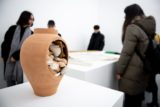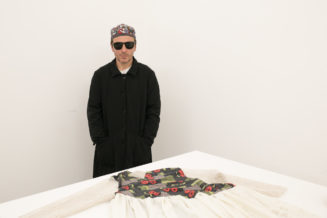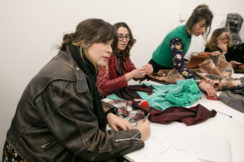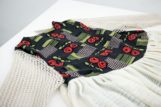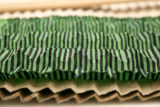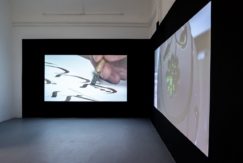Dear Shaded Viewers,
The Artist’s Table A.I. Artisanal Intelligence was curated by Clara Tosi Pamphili and Alessio de ‘Navasques, it was the 16th edition and this time the focus was on the table as a symbol to attract people’s attention to the process and the activity generated by skill. The idea of the process of creation is exemplified by the two videos by Turkish artist Ali Kazma made available by the Galleria Francesca Minini of Milan. “Crystal” and “Calligraphy” focus on two forms of making as the expression of the human will: writing or glass blowing.
The workshops were divided into 3 days: Andrea Anastasio, the “master” of the first day, followed by Paolo di Landro on the second day and by Livia Crispolti and the boutique Sorelle Antonini on the third day.
Andrea Anastasio is the master of ceramics. After studying philosophy, he initiated a cultural journey that led him to take part in the cataloguing of Islamic architecture in India, in researches on the innovation of traditional artisanal techniques, collaborations with architecture firms, publishing houses and museums. Interested in the poetics of conceptual art and its potential convergence with industrial design, he designs furniture and objects for internationally acclaimed Italian companies. His research focuses on the manipulation of objects, consumption goods and household materials, with the goal of combining different languages and meanings.
Paolo di Landro created the Officina Sartoriale (tailor’s workshop) called “Il riscatto del capo” (the garment’s redemption), where he began to reutilize existing garments well before the giants of global fashion. He collects, recycles and redesigns both poor and rich garments, which have already been used and which, in some cases, may now look old-fashioned. Paolo di Landro embraces the challenge of playing with ugly garments and praising their virtues and he is capable of turning chavvy clothes into fine ones. His “poor technology” approach (as Andrea Branzi calls it) influences the production and distribution culture of a different haute couture.
Livia Crispolti is the master of yarns and fabrics. She is a textile designer and she completed her education and training in Como, in Florence and at the Textile Museum of Washington, D.C. Since 1996 she has been writing about textile culture, a field in which she has carried out many projects, taught and curated exhibitions. Her brand, “Livia Crispolti tessuto a mano”, produces unique and small-series fabrics using manual looms. Until 2014 she was the curator of the exhibition space Vetrine Ripetta 130/133 of the Archivio Crispolti Arte Contemporanea of Rome, where she studied the cross-fertilization between textile culture and visual arts.
In this edition, the historical boutique Sorelle Antonini will bid farewell to the world of fashion before its official closure. The 120-year-old store is the only historical boutique to be specialized in the Pieghettato Artigianale (artisanal pleats) technique. The history of fashion and of cinema are going to lose some really valuable know-how, a unique technique that has been used to design costumes and dresses, but also to restore and repair fabrics. There is a very famous picture which perfectly represents what the Sorelle Antonini brand means to fashion and cinema: Marylin Monroe’s white pleated full circle skirt dress, in which the geometrical pleats perfectly adapt to the shape of her body. This technique was also used by the Fontana sisters, Valentino, Sarli and Gattinoni, as well as for other divas like Greta Garbo. The boutique will explain and transfer a know- how which will disappear with its closure.
ALI KAZMA
Galleria Francesca Minini, Milan
The two videos by Ali Kazma are part of the Resistance series, which was first exhibited in the Turkish pavilion at the 55th Venice Biennale. The videos are part of a visual tale on the efforts which men and women make to pursue continuity, control and physical wellbeing through the creation of a final product, which may be a material work of art or a performance. “Crystal” was shot in France, in a glass factory founded in 1584 which produces elegant, luxury objects using a fragile material that requires the perfect control of gestures. The coordinated movements of workers and craftsmen are somewhat reminiscent of a choreography. Kazma’s camera effectively captures the magical ability of human beings of giving shape to objects. “Calligraphy” shows the hand of a calligrapher while it moves slowly on a sheet of paper and leaves permanent signs that are the extension of the arm.
BASEMENT ROMA is a non-profit organization and self-sustaining exhibition space managed by CURA. It is dedicated to experimentation, discussion and the production of exhibition projects, presentations, conferences and editorial initiatives, in collaboration with artists, curators and independent and institutional players. Since its foundation in 2012, it has been based in the hidden basement of the headquarters of the CURA magazine, in the heart of the Prati neighbourhood in Rome.
Altaroma thanks the Accademia di Costume e di Moda for making it possible to build a “fully- fledged” workshop.
Later,
Diane


